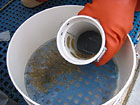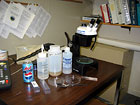

 | |||||||
|
|
Journals 2004/2005Leesa Wingo
July 19, 2004 10 am start, to Sitakaday for plankton tows. The tide is flooding so we are starting our sampling at station 5 then to line then to station 1 up bay to s. end of Willoughby island. All tows are in the central channel, with the tour ships, of course. (Click on thumbnail below for full version pop-up) Sidakaday narrows have unusual currents that can make boat travel miserable. The underwater mixing also affected our plankton tows - the front line was going a little too slow, due to strong underwater currents preventing the boat from moving. This was because the surface current moves one direction, while the underwater current goes the opposite. (Click on thumbnail below for full version pop-up) The plankton tows were done at three depths: surface, 10 meters and 30 meters. A computerized dive watch was attached to the net to check the time and accuracy of the deeper dives. When the net was pulled up with the hydraulic winch, it was then hosed down, and the plankton would get trapped in the "cod end" of the net. This is a detachable cup with screen-covered drain holes. The cod end is removed and cleaned out into a sieve where the sample is further cleaned of phytoplankton and captured into a sample bottle. Once in the bottle, it is preserved with alcohol and labeled for identification purposes back in the lab. (Click on thumbnails below for full version pop-up) It was difficult to get the plankton net to fish at the correct depth at first, but with practice, Lisa and Erica mastered the process. Return to Journals Index |
||||||





